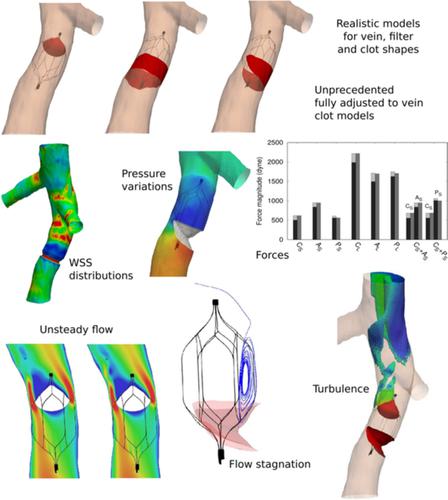当前位置:
X-MOL 学术
›
Int. J. Numer. Method. Biomed. Eng.
›
论文详情
Our official English website, www.x-mol.net, welcomes your
feedback! (Note: you will need to create a separate account there.)
Hemodynamic effects of blood clots trapped by an inferior vena cava filter.
International Journal for Numerical Methods in Biomedical Engineering ( IF 2.2 ) Pub Date : 2020-05-19 , DOI: 10.1002/cnm.3343 Josep M López 1 , Gerard Fortuny 1 , Dolors Puigjaner 1 , Joan Herrero 2 , Francesc Marimon 3
International Journal for Numerical Methods in Biomedical Engineering ( IF 2.2 ) Pub Date : 2020-05-19 , DOI: 10.1002/cnm.3343 Josep M López 1 , Gerard Fortuny 1 , Dolors Puigjaner 1 , Joan Herrero 2 , Francesc Marimon 3
Affiliation

|
The alteration of blood flow around an OPTEASE inferior vena cava filter with one or two blood clots attached was investigated by means of computational fluid dynamics. We used a patient‐specific vein wall geometry, and we generated different clot models with shapes adapted to the filter and vein wall geometries. A total of eight geometries, with one or two clots and a total clot volume of 0.5 or 1 cm3, were considered. A non‐Newtonian model for blood viscosity was adopted and the possible development of turbulence was accounted for by means of a three‐equation model. Two blood flow rates were considered for each case, representative for rest and exercise conditions. In exercise conditions, flow unsteadiness and even turbulence was detected in some cases. Pressure and wall shear stress (WSS) distributions were modified in all cases. Clots attached to the filter downstream basket considerably increased averaged WSS values by up to almost 50%. In all the cases a flow recirculation region appeared downstream of the clot. The degree of flow stagnation in these regions, an indicator of propensity to thrombogenesis, was estimated in terms of mean residence times and mean blood viscosity. High levels of flow stagnation were detected in rest conditions in the wake of those clots that were placed upstream from the filter. Our results suggest that one downstream placed big clot, showing a higher tendency to induce flow instabilities and turbulence, might be more harmful than two small clots placed in tandem.
中文翻译:

被下腔静脉滤器截留的血凝块的血流动力学效应。
通过计算流体动力学研究了 OPTEASE 下腔静脉过滤器周围血流的变化,该过滤器附有一个或两个血凝块。我们使用了患者特定的静脉壁几何形状,并生成了形状适合过滤器和静脉壁几何形状的不同凝块模型。总共八种几何形状,有一个或两个凝块,总凝块体积为 0.5 或 1 cm 3, 被认为是。采用了血液粘度的非牛顿模型,并通过三方程模型考虑了湍流的可能发展。每种情况都考虑了两种血流量,代表休息和运动条件。在运动条件下,在某些情况下会检测到流动不稳定甚至湍流。在所有情况下都修改了压力和壁面剪切应力 (WSS) 分布。附着在过滤器下游篮子上的凝块使平均 WSS 值显着增加了近 50%。在所有情况下,血凝块下游都出现了流动再循环区域。这些区域的血流停滞程度是血栓形成倾向的指标,根据平均停留时间和平均血液粘度进行估计。在放置在过滤器上游的凝块之后,在静止条件下检测到高水平的流动停滞。我们的结果表明,一个下游放置的大凝块显示出更高的诱发流动不稳定性和湍流的趋势,可能比串联放置的两个小凝块更有害。
更新日期:2020-05-19
中文翻译:

被下腔静脉滤器截留的血凝块的血流动力学效应。
通过计算流体动力学研究了 OPTEASE 下腔静脉过滤器周围血流的变化,该过滤器附有一个或两个血凝块。我们使用了患者特定的静脉壁几何形状,并生成了形状适合过滤器和静脉壁几何形状的不同凝块模型。总共八种几何形状,有一个或两个凝块,总凝块体积为 0.5 或 1 cm 3, 被认为是。采用了血液粘度的非牛顿模型,并通过三方程模型考虑了湍流的可能发展。每种情况都考虑了两种血流量,代表休息和运动条件。在运动条件下,在某些情况下会检测到流动不稳定甚至湍流。在所有情况下都修改了压力和壁面剪切应力 (WSS) 分布。附着在过滤器下游篮子上的凝块使平均 WSS 值显着增加了近 50%。在所有情况下,血凝块下游都出现了流动再循环区域。这些区域的血流停滞程度是血栓形成倾向的指标,根据平均停留时间和平均血液粘度进行估计。在放置在过滤器上游的凝块之后,在静止条件下检测到高水平的流动停滞。我们的结果表明,一个下游放置的大凝块显示出更高的诱发流动不稳定性和湍流的趋势,可能比串联放置的两个小凝块更有害。











































 京公网安备 11010802027423号
京公网安备 11010802027423号